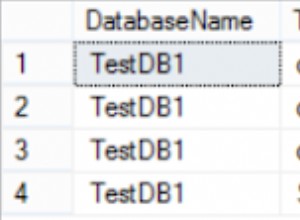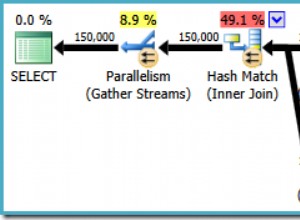Esistono due modi per eseguire un PIVOT statico in cui si codificano i valori e dinamico in cui vengono determinate le colonne durante l'esecuzione.
Anche se vorrai una versione dinamica, a volte è più facile iniziare con un PIVOT statico e poi lavorare verso uno dinamico.
Versione statica:
SELECT studentid, name, sex,[C], [C++], [English], [Database], [Math], total, average
from
(
select s1.studentid, name, sex, subjectname, score, total, average
from Score s1
inner join
(
select studentid, sum(score) total, avg(score) average
from score
group by studentid
) s2
on s1.studentid = s2.studentid
) x
pivot
(
min(score)
for subjectname in ([C], [C++], [English], [Database], [Math])
) p
Vedi SQL Fiddle con demo
Ora, se non conosci i valori che verranno trasformati, puoi utilizzare Dynamic SQL per questo:
DECLARE @cols AS NVARCHAR(MAX),
@query AS NVARCHAR(MAX)
select @cols = STUFF((SELECT distinct ',' + QUOTENAME(SubjectName)
from Score
FOR XML PATH(''), TYPE
).value('.', 'NVARCHAR(MAX)')
,1,1,'')
set @query = 'SELECT studentid, name, sex,' + @cols + ', total, average
from
(
select s1.studentid, name, sex, subjectname, score, total, average
from Score s1
inner join
(
select studentid, sum(score) total, avg(score) average
from score
group by studentid
) s2
on s1.studentid = s2.studentid
) x
pivot
(
min(score)
for subjectname in (' + @cols + ')
) p '
execute(@query)
Vedi SQL Fiddle con demo
Entrambe le versioni produrranno gli stessi risultati.
Giusto per completare la risposta, se non hai un PIVOT funzione, quindi puoi ottenere questo risultato usando CASE e una funzione aggregata:
select s1.studentid, name, sex,
min(case when subjectname = 'C' then score end) C,
min(case when subjectname = 'C++' then score end) [C++],
min(case when subjectname = 'English' then score end) English,
min(case when subjectname = 'Database' then score end) [Database],
min(case when subjectname = 'Math' then score end) Math,
total, average
from Score s1
inner join
(
select studentid, sum(score) total, avg(score) average
from score
group by studentid
) s2
on s1.studentid = s2.studentid
group by s1.studentid, name, sex, total, average
Vedi SQL Fiddle con demo




